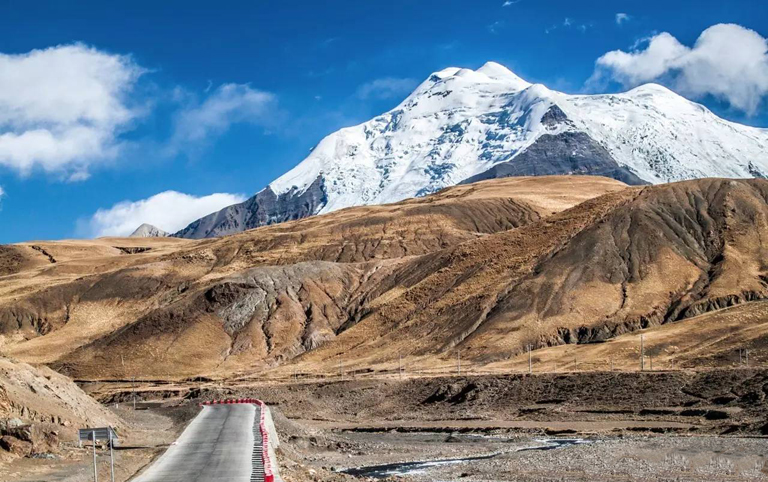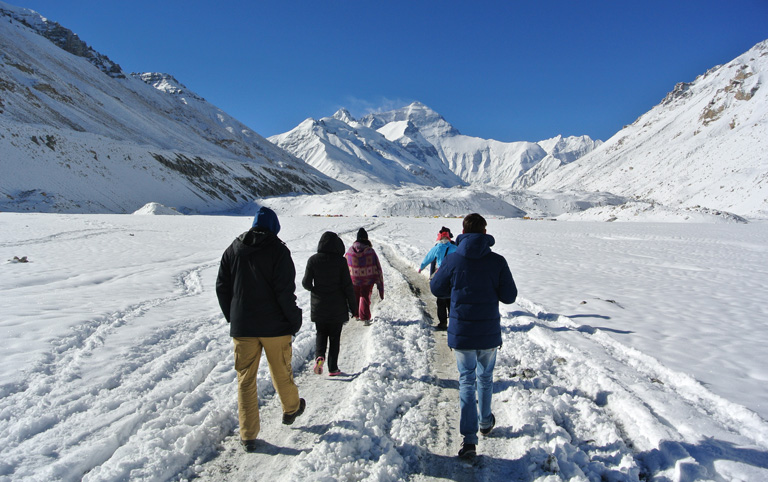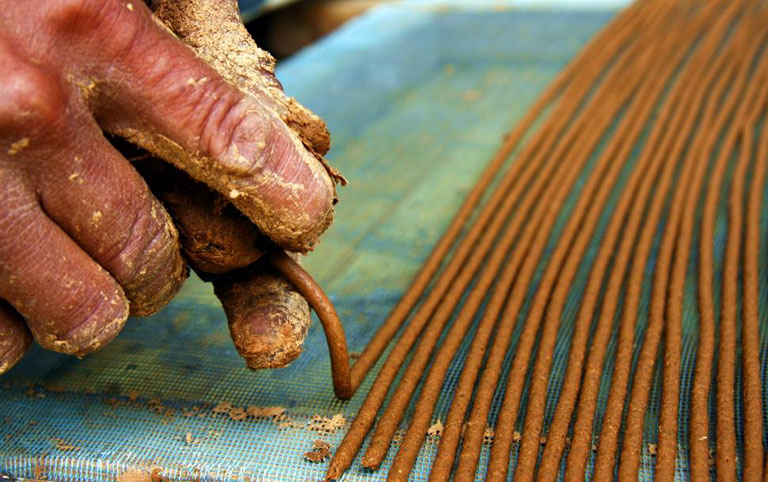For ambitious travelers who love trekking while surrounded by stunningly beautiful landscapes. This adventurous journey will fulfill your passion for nature and open up a new world to explore. Three days of trekking will give you plenty of time to marvel at the magnificent scenery of the world's highest mountain, Mt. Everest, and the surrounding peaks; Gaze up at Mt. Everest to get great photographic shooting opportunities during sunrise and sunset.
Highlights of this tour:
- You will have 4-5 days to adapt to the high altitude and prepare for the trekking to Mount Everest, which is also a great time of visiting the most important attractions in Lhasa, Gyantse and Shigatse;
- Enjoy harsh but beautiful high plateau landscapes that can only be seen in Tibet Plateau;
- Trek from Old Tingri Town to the Everest Base Camp at a leisure pace.
Tour Brief Information
- Tour price: from Request
- Tour code: TD-AT-12A
- Tour Type: Private Customizable Tour Package
- Destination: Lhasa / Gyantse / Shigatse / Old Tingri / Everest Base Camp / Lhasa
- Duration: 12 days and 11 night
- Departure: Flexible
- Travel Theme:



- Best Time:



- Physical Level
- Tour Pace
Leisure
- Max Altitude
5,200m
- Itinerary Details
- Price Guide & Booking
- Trip FAQs
- Reviews
- Make an Enquiry
Your tour - at a glance
Day 1~3 Arrival & Lhasa Tour
Day 4~5 Lhasa to Old Tingri via Gyantse and Shigatse
Day 6~9 Trek to Mount Everest Base Camp
Day 10~11 Mount Everest - Shigatse - Lhasa
Day 12 Lhasa Departure
Itinerary Details - Day by Day
Day 1 Lhasa Arrival
Welcome to the roof of the world! You will be picked up by local tour guide at the airport hall or train station, then be escorted to your hotel in Lhasa city in a private vehicle.
After arrival at your hotel, the rest of the day is free for you to explore the local areas and acclimatize yourself to the air, temperature and high altitude of Lhasa.
High Altitude Acclimation Tips:1) go for some leisure walking to acclimate the high altitude but avoid strenuous activity after arrival; 2) you'd better not have bath, in case of catching a cold; 3) drink more water, and have some fruit; 4) have a good rest...
Day 2 Lhasa ( B )
Start today’s Lhasa exploration with an exciting visit to the landmark - Potala Palace which is regarded as one of the most beautiful architectural building in the world. You will climb up the palace along the zigzag stone paths with white-and-red walls to the top of the palace where you can not only appreciate the exotic Tibetan-style architecture, but also get a great view of Lhasa’s urban areas, then walk into the inner space of Potala Palace to explore the stately chapels and learn about the history of the palace.
Continuing your exploration, you will then get to Jokhang Temple which is considered as the spiritual heart of Tibetan Buddhism. Each day, there are thousands of pilgrims coming from different places in Tibet to the temple to worship to the Buddha. This temple is also known as the “house of Buddha” because it keeps the precious Jowo Rinpoche, the life-sized (5 foot/1.5m) image of the Shakyamuni at the age of 12. The last site for today’s exploration is the famous Barkor Street. It is a circular and wide street encircling the Jokhang Temple. The local people like to walk on the street for several circles usually in the late afternoon as a daily tradition of pilgrimage. The street also has many shops selling a wide variety of traditional Tibetan goods, religious items and handcrafts.
Tips of today: 1) there are 1,080 steps up to climb to the top of Potala Palace, so don’t walk in a rush, which may cause high altitude sickness; 2) taking photos is not allowed inside the palace; 3) today you will be mainly outside, please bring some water, a hat, sun cream, and sun glasses with you.
-
 Tibet Potala Palace with fabulous architecture
Tibet Potala Palace with fabulous architecture
-
 Prayers at Jokhang Temple
Prayers at Jokhang Temple
-
 Barkhor Street
Barkhor Street
Day 3 Lhasa ( B )
After breakfast, you will firstly go to visit the beautiful Norbulingka which used to be the former summer palace of Dalai Lamas in the ancient time, and now is a public park. It is famous for its Potrang, the private palaces of former Dalai lamas with grandiose Tibetan architecture style. Next, drive several kilometers to the western outskirts of Lhasa to visit Drepung Monastery. Drepung, in Tibetan, means “prosperity”. Since its establishment, Drepung Monastery has always been one of the most important Buddhist monasteries in Tibet. In its heyday, there were more than 10,000 monks lived and studied in the monastery. Throughout its history, many important and famous Tibetan leaders used to study here, especially the Dalai Lamas. So Drepung Monastery is also respectfully known as the “Mother School of Dalai Lamas”.
In the afternoon, you will be taken to another famous monastery in Lhasa - Sera Monastery. It is famous for the spectacular “Buddhism Debating”. As a daily routine, the monks gather in a courtyard, and debate on the Buddhist doctrines with supplemented gestures, which is thought to be helpful to facilitates better comprehension of the Buddhist philosophy to attain higher levels of study. After enjoying the "Buddhism Debating", you will be transferred back to the city. The rest time is your own free time to rest.
The Etiquette of Visiting Monastery: 1) you shouldn’t wear short and uncover shoulders; 2) taking off your sunglasses and hat before entering the chapels; 3) taking photos is usually not allowed inside the chapels.
-
 Scripture Debating is a good way to check the knowledge
Scripture Debating is a good way to check the knowledge
-
 Rock Paintings in Drepung Monastery
Rock Paintings in Drepung Monastery
-
 Norbulingka Park is a good summer resort in Lhasa
Norbulingka Park is a good summer resort in Lhasa
Day 4 Lhasa - Gyantse - Shigatse ( B )
Today, you will leave Lhasa and drive about 8 hours to Shigatse, the second largest city in Tibet. It may be a long journey, but there are many things to do along the road. The first site you will reach is the holy Yamdrok Lake. As the largest fresh lake in the northern of the Himalaya Mountains, it spreads about 675 square meters from south to north, like an eardrop lying in the arms of snow-capped giant mountains. Viewing from a distance, you can see fertile pastures full of yaks and sheep, and some small Tibetan villages along the lakeshore. Keeping driving not so far from Yamdrok Lake, you will see the imposing Karola Glacier towering aloft on the right side of the road.
Continuing your trip, you will get to the historical city of Gyantse. Feel hungry? Have a good lunch in the town, then go to visit the mysterious Palcho Monastery. The monks and tradition of three important sects of Tibetan Buddhism - Sakyapa, Zhalupa and Gelukpa, peacefully coexist in this monastery. Its Kumbum, which is 35 meters high and has 76 small chapels with hundreds images of Kriyatantras , is believed to be the largest such structure in Tibet.
After the Gyantse sightseeing, keep drive about 3 hours, you will arrive at your hotel in Shigatse. Have a good rest!
Tips of today: 1) wear warm clothes to prevent from cold and wild; 2) pack some food and drinks with you because you will spend much time on the road.
-
 Yamdrok Lake is as beautiful as a sapphire
Yamdrok Lake is as beautiful as a sapphire
-
 Palcho Monastery is famous for its Kumba
Palcho Monastery is famous for its Kumba
-
 Karola Glaceier shines a brilliant white in the sunlight
Karola Glaceier shines a brilliant white in the sunlight
Day 5 Shigatse – Old Tingri ( B )
After breakfast, you will going to visit the official seat of Panchen Lama - Tashilhunpo Monastery, also an influential monastery Geleg School. Covering an area of nearly 150,000 square meters, the monastery is one of the largest temples in Tibet with about 57 halls and 3600 rooms. Among them, the Coqen Hall can hold 2000 monks to take part in Buddhist activities. Featuring an interesting sprawling amalgam of traditional Tibetan monastic style, those halls, chapels and other structures are connected by precipitous steps and narrow cobblestone alleys. The interplay between the golden roofs and the white, red and black exterior walls creates a striking composition. Here you will see a giant statue of Future Buddha, the largest one of its kind on earth ( 26.2 meters high and 11.5 meters wide ), decorated with precious pearls, turquoises, corals and ambers.
Then you will leave Shigatse for the final destination of today - Old Tingri Town. Enjoy the magnificent plateau landscape along the road.
-
 Tashilhunpo Monastery is the oldest and largest Gelugpa Monastery
Tashilhunpo Monastery is the oldest and largest Gelugpa Monastery
Day 6 Trek from Old Tingri to Lungthang ( B, L, D )
Trek: 5 hours, 12km
Your trekking begins in Old Tingri. Hike through the Tingri Plain. Along a part of the Ra-chu Valley, you’ll see the beautiful valley scenery with extensive meadows and herds of sheep and goats.
Overnight in a comfortable camp site in Lungthang.
Day 7 Trek to Lamna La ( B,L,D )
Trek: 7 hours, 12km
Today you’ll have a challenging trek, because you’ll go up into the mountains. There is a lot of walking uphill as you climb towards the top to the Lamna La. Be sure to take breaks and rest if you are feeling fatigued.
Camping at beyond Lamna La tonight.
Day 8 Trek to Zommug ( B, L, D )
Trek: about 5-6 hours
In the morning, you’ll descend into an area with lush vegetation. The only other people you may encounter are yak herders and their families. Camp will be made in the small village of Zommug. Truly amazing views can be seen as the sun sets in this barren town.
Day 9 Trek to Rongbuk Monastery and Everest Base Camp ( B, L, D )
On your last day of trekking, you’ll wind your way to the end of the trek - Rongbuk Monastery.As you get the great sight of the mighty Everest from Rongbuk Monastery, you will immerse in a solemn ethereal mood and find all the efforts you have made along the long way are not in vain.
Stay overnight in Rongbuk Guest House or a local tent of Everest Base Camp.
-
 Rongbuk Monastery on the Mount Everest
Rongbuk Monastery on the Mount Everest
-
 Mount Everest Base Camp Walking Around
Mount Everest Base Camp Walking Around
Day 10 Mount Everest - Shigatse
Wake up early to enjoy the marvelous sunrise on the peak of the world. The top part of the mountain is covered with snow all the year round, and when the sun shines on the mountain, the peak is like a giant white pyramid. In bright days, you can always see a wisp of cloud hanging above the top of Mount Everest. It flies eastward in the fast western wind just like a flapping flag. This unique phenomenon is the spectacular “Cloud Flag”. The cloud will change from surging waves into a thin cooking smoke or from galloping steeds into the mysterious veil of a goddess.
Till now your Mount Everest adventure is about to end. The rest of today is to drive back to Shigatse City. You will get to Shigatse in the afternoon, then take a good rest.
Tips of today: 1) to protect the environment of Mount Everest, currently Everest Base Camp is not open for tourists – the Everest landscape can be enjoyed at Rongbuk Monastery and Tibetan Tent Camp as well. The base camp marker, a tablet reading “Mt. Qomolangma Base Camp” has been transferred to the Tibetan Tent Camp. You are suggested to take a photo at the marker to commemorate your wonderful adventure tour; 2) the sunrise usually starts around 6:30 am to 7am on Mount Everest; 3) keep warm all the time.
Day 11 Shigatse – Lhasa ( B )
Today you'll drive back to Lhasa (5 hours) along the legendary Yaluzangbu River, the mother river of Tibet. On the halfway, you will take a visit to Nyemo Tunba which was the home of Tunmi Sangbuzha who invented the Tibetan character as well as the famous Tibetan Tibetan Incense. Here in Tunba, you also have a chance to witness the process of making Tibetan Incense with water mill. At the same time, the scenery here is fabulous - ancient cypress trees, green willows, murmuring river...
Take a good rest in Lhasa.
-
 A worker is making Tibetan Incense
A worker is making Tibetan Incense
Day 12 Lhasa Departure ( B )
The day is free until you are escorted to the airport or train station.
Tips: Please pack your luggage carefully, especially for things like tooth brush, camera, mobile phone, phone charger, towel, wallet. If your flight is arranged in the afternoon, please make sure you check out the hotel before 12pm.
Useful Trip Notes
-
- 1. Tibet Permits Guaranteed
To travel in Tibet, all Non-Chinese passport holders need to have a Tibet Travel Permit which is issued by Tibet Tourism Bureau in Lhasa. And only Chinese travel agencies like Tibet Discovery can apply for the permit on behalf of tourists. You must obtain it before your tour starting because the permit will be checked when you board your flight/train to Tibet. Traveling with Tibet Discovery, you don't have to worry about the complicated procedures of Tibet Travel Permit application. All you have to do is to confirm a tour package with us and send us your passport and Chinese visa copies at least 15~20 days in advance before your tour, then we will take care of all the rest things. Once the permit is issued, we will deliver to your address in China, such as your hotel, local travel agency, etc.
-
- 2. Available Months to Visit Tibet
Generally speaking, April to October is the best time. July and August are the peak season and rainy season. It is usually snowy and cold in winter, which is not suitable for visit Mount Everest, Namtso and Mount Kailash regions. While other places such as Lhasa, Gyantse and Shigatse are suitable for travel all year around. The temperatures in daytime and night differs a lot, usually 5~15℃ in the daytime and -5~0℃ in the night, so please wear accordingly.
-
- 3. High Altitude Sickness
The average altitude of Tibet is about 4000 meters above the sea level (Lhasa: 3700m; EBC: 5200m; Namtso: 4718m). You may suffer a bit from High Altitude Sickness in the beginning days of your Tibet trip if you haven’t had rich high plateau travel experience. But don’t worry too much, the high altitude can be acclimatized usually in 2~3 days. Our suggestion is to take a physical examination and get suggestions from your doctor, and also bring some medicines to prevent from High Altitude Sickness before your trip. While in Tibet, you should keep warm all the time, avoid strenuous activities, drink more water and eat more vegetables and carbohydrates. You’d better not take showers during the first two days after your arrival in Tibet. If you don’t feel well, get help from your tour guide or go to the hospital without any delay.
-
- 4. How to Go to Tibet
Basically you have two options – flight and train. Currently, you can take a flight to Lhasa from Beijing(4.5hrs), Xian(3.7hrs), Chengdu(2.5hrs), Chongqing(3hrs), Kunming(3hrs), Kathmandu (1.5hrs), etc. Among all these cities, Chengdu and Xian have more frequent flights to Lhasa.
If you prefer a train travel, you can take a train to Tibet from Beijing(40.5hrs), Xian(32hrs), Chengdu(43hrs), Shanghai(47hrs), Chongqing(42hrs), Lanzhou(25hrs), Xining(22hrs), Guangzhou(54hrs). -
- 5. Packing and Wearing Ideas
Firstly you can’t forget your passport and Chinese Visa. A large backpack and a smaller one are recommended (the smaller one can be used for daily activities). Also bring necessary medicine you need. Other stuffs like sunglasses, snow glasses, hats, lip balm, sun block are recommended.
As for wearing, you are suggested to dress in layers (both thin and thick jackets). Down jacket is necessary in Spring and Autumn. A pair of durable and comfortable shoes is necessary.
Recommended Tibet Group Tour Packages
Escorted by a skilled driver and companied by a professional local tour guide to organize all the activities, all you have to do is to enjoy your fantastic Tibet journey.Following are some other recommended Tibet group tour packages that you may be interested in. You can also contact us to customize a trip if you want..
-

Lhasa / Gyantse / Shigatse / Everest / Lhasa
8 Days Lhasa to Mount Everest Private Tour
Highlights: Potala Palace, Yamdrok Lake, Tashilhunpo Monastery, Mt. Everest
-

Lhasa / Shigatse / Mount Everest / Namtso Lake / Lhasa
9 Days Tibet Discovery Tour plus Everest and Namtso Expedition
Highlights: Potala Palace, Yamdrok Lake, Mt. Everest, Namtso Lake




 Karen
Karen Wonder
Wonder Jack
Jack Rita
Rita Johnson
Johnson Vivien
Vivien Wing
Wing Ariel
Ariel Leo
Leo Tracy
Tracy Evelyn
Evelyn April
April Phoebe
Phoebe Kelly
Kelly Shirley
Shirley Reya
Reya Juliet
Juliet Elk
Elk Felix
Felix Sean
Sean